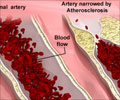Researchers at the Scotland-based University of Edinburgh have led a new study that suggests that the ankle brachial index (ABI) may be useful to improve the accuracy of cardiovascular risk prediction. ABI is the ratio of systolic pressure at the ankle to that in the arm which is used to indicate the risk of peripheral artery disease and atherosclerosis.
Reported in the journal JAMA, the research was based on a meta-analysis of 16 previous studies.Lead researcher Dr. Gerry Fowkes revealed that the studies included a total of 24,955 men and 23,339 women who had ABI measured at baseline, and were followed up to detect total and cardiovascular mortality.
The researchers observed that the 10-year cardiovascular mortality in men with a low ABI (0.90 or less) was 18.7 per cent and with normal ABI (1.11 - 1.40) was 4.4 per cent, about a four times higher risk of cardiovascular death for men with low ABI.
They said that corresponding mortalities in women were 12.6 percent and 4.1 percent.
The risks remained elevated after adjusting for the Framingham risk score (FRS), which is often considered the reference standard for estimating the risk despite its limited accuracy.
A low ABI (0.90 or less) was associated with approximately twice the 10-year total mortality, cardiovascular mortality, and major coronary event rate compared with the overall rate in each FRS category.
Advertisement
"These changes [for men] from higher to lower categories of risk would likely have an effect on decisions to commence preventive treatment, such as lipid-lowering therapy .... In contrast, the main effect in women of inclusion of the ABI would be that many at low risk with the FRS (less than 10 percent) would change to a higher risk level," the authors write.
Advertisement
According to the researchers, the equipment is inexpensive, and the procedure is simple and can be performed by a suitably trained nurse or other health care professional.
"The results of our study indicate that, when using the FRS, this (considering ABI for the purposes of cardiovascular risk assessment) may indeed be justified to improve prediction of cardiovascular risk and provision of advice on ways to reduce that risk. A new risk equation incorporating the ABI and relevant Framingham risk variables could more accurately predict risk and our intention is to develop and validate such a model in our combined data set," the authors conclude.
Source-ANI
RAS/S












